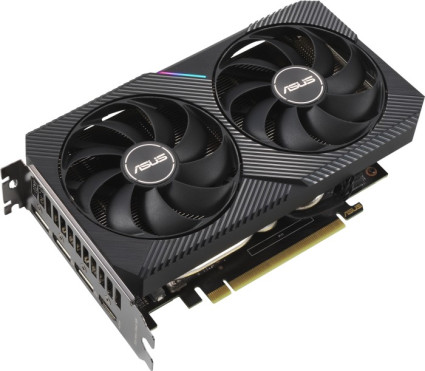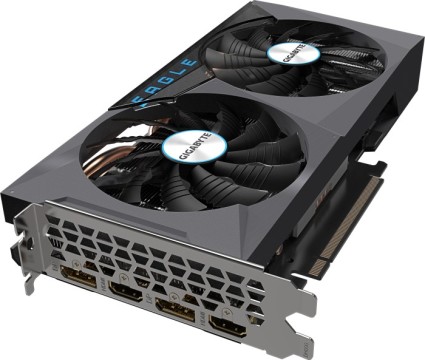
ASUS Dual RTX 3060 OC vs. GIGABYTE RTX 3060 Eagle OC 12G (Rev. 2.0) (LHR)
In diesem Vergleich von ASUS Dual RTX 3060 OC versus GIGABYTE RTX 3060 Eagle OC 12G (Rev. 2.0) (LHR) vergleichen wir die technischen Daten der beiden GPUs. Welche Grafikkarte ist schneller? Hier gibt es FPS & Benchmarks in Gaming und Anwendungen. Außerdem Daten zu Verbrauch, Effizienz (FPS pro Watt) und Preis-Leistung (FPS pro Euro).

Allgemeine Informationen
| Günstigster Preis |
|
|
| Hersteller | ASUS | GIGABYTE |
| Serie | NVIDIA GeForce RTX 3060 - 8GB | NVIDIA GeForce RTX 3060 - 12GB |
| Chip-Architektur | Ampere (ab 2020/Q3) | Ampere (ab 2020/Q3) |
| Chip-Bezeichnung | GA106-302-A1 | GA104-150-KC-A1 |
| Fertigung | Samsung 8 nm | Samsung 8 nm |
| Chip-Größe | 276 mm² | 392 mm² |
| Kühlung | 2x Axial-Lüfter (95mm) mit 0dB-Zero-Fan-Modus (bis 55°C) | 2x Axial-Lüfter (100mm) mit 0dB-Zero-Fan-Modus |
Spezifikationen
Die Anzahl der Recheneinheiten, die Taktraten sowie die Größe des Cache sind neben der zugrunde liegenden Architektur ein Indiz für die Leistungsfähigkeit eines Produkts. Die ASUS Dual RTX 3060 OC verfügt wie die GIGABYTE RTX 3060 Eagle OC 12G (Rev. 2.0) (LHR) über gleich viele Recheneinheiten mit 3584 FP32-ALUs. Der Boost-Takt der ASUS Dual RTX 3060 OC liegt mit 1837 MHz etwas mehr als/wie bei der GIGABYTE RTX 3060 Eagle OC 12G (Rev. 2.0) (LHR) mit 1807 MHz.
| Basis-Takt | 1320 GHz | 1320 GHz |
| Boost-Takt | 1837 GHz | 1807 GHz |
| Übertaktung | +90MHz Boost (OC-Profil) +60MHz Boost (Standard-Profil) |
+30MHz Boost |
| Chip-Konfiguration | 28SM (3584SP / 112TMU / 48ROP) | 28SM (3584SP / 112TMU / 64ROP) |
| Rechenleistung | 13.38 TFLOPS (FP16), 13.38 TFLOPS (FP32), 0.21 TFLOPS (FP64) | 12.95 TFLOPS (FP16), 12.95 TFLOPS (FP32), 0.2 TFLOPS (FP64) |
Kompatibilität und Abmessungen
| Schnittstelle | PCIe 4.0 x16 | PCIe 4.0 x16 |
| Abmessung | 200 | 242 |
| Gesamthöhe | Dual Slot (2.0 Slots) | Dual Slot |
| Bauform | PCIe-Karte (full height) | PCIe-Karte (full height) |
| Slotblende | full height | full height |
| Leistungsaufnahme (TDP) | 170W | 170W |
| Zusätzliche Stromanschlüsse | 1x 8-Pin PCIe | 1x 8-Pin PCIe |
Speicher
Die ASUS Dual RTX 3060 OC verfügt über 8 GB GDDR6 Videospeicher, welcher an ein 128 Bit Speicherinterface angebunden ist und mit 15 Gbps taktet. Die Speicherbandbreite liegt damit bei 240 GB/s. Bei der GIGABYTE RTX 3060 Eagle OC 12G (Rev. 2.0) (LHR) sind dagegen 12 GB GDDR6 VRAM mit einer Taktrate von 15 Gbps an einem 192 Bit Speicherinterface angeschlossen. Daraus resultiert eine Speicherbandbreite von 360 GB/s.
| Speicherkapazität | 8 GB | 12 GB |
| Speichertyp | GDDR6 | GDDR6 |
| Speicherinterface | 128 Bit | 192 Bit |
| Speichertakt | 15 Gbps (1875 MHz) | 15 Gbps (1875 MHz) |
| Speicherbandbreite | 240 GB/s | 360 GB/s |
Videoanschlüsse
| HDMI | 1x HDMI 2.1 | 2x HDMI 2.1 |
| DisplayPort | 3x DisplayPort 1.4a | 2x DisplayPort 1.4a |
Transcoding-Engine
| NVENC | 1x (7th Gen, max. Sessions: 8) | 1x (7th Gen, max. Sessions: 8) |
| NVDEC | 1x (5th Gen) | 1x (5th Gen) |
Encoding
| H.265 | ✓ (4K YUV 4:2:0 / 4K YUV 4:4:4 / 4K Lossless / 8K / HEVC 10bit support / HEVC B Frame support) | ✓ (4K YUV 4:2:0 / 4K YUV 4:4:4 / 4K Lossless / 8K / HEVC 10bit support / HEVC B Frame support) |
| H.264 | ✓ (YUV 4:2:0 / YUV 4:4:4 / Lossless) | ✓ (YUV 4:2:0 / YUV 4:4:4 / Lossless) |
Decoding
| AV1 | ✓ (8bit / 10bit) | ✓ (8bit / 10bit) |
| H.265 | ✓ (8bit 4:2:0 / 10bit 4:2:0 / 12bit 4:2:0 / 8bit 4:4:4 / 10bit 4:4:4 / 12bit 4:4:4) | ✓ (8bit 4:2:0 / 10bit 4:2:0 / 12bit 4:2:0 / 8bit 4:4:4 / 10bit 4:4:4 / 12bit 4:4:4) |
| H.264 | ✓ | ✓ |
| VP9 | ✓ (8bit / 10bit / 12bit) | ✓ (8bit / 10bit / 12bit) |
| VP8 | ✓ | ✓ |
| VP8 | ✓ | ✓ |
| VP8 | ✓ | ✓ |
| VP8 | ✓ | ✓ |
API-Unterstützung
| DirectX | 12 Ultimate (12_2) | 12 Ultimate (12_2) |
| CUDA | 8.6 | 8.6 |
| Vulkan | 1.3 | 1.3 |
| OpenCL | 3.0 | 3.0 |
| OpenGL | 4.6 | 4.6 |
| Shader Modell | 6.7 | 6.7 |
| Multi-GPU-Unterstützung | - | - |
Chip-Unterstützungen
| Raytracing | ✓ (2nd Gen NVIDIA RTX) | ✓ (2nd Gen NVIDIA RTX) |
| NVIDIA Tensor | ✓ (3rd Gen) | ✓ (3rd Gen) |
| HDCP | 2.3 | 2.3 |
Sonstiges
| Einführung | 12.10.2022 | 01.09.2021 |
| Herstellergarantie | drei Jahre (Abwicklung über Händler) | drei Jahre (ab Produktionsdatum, Abwicklung über Händler) |
Spiele

- NVIDIA GeForce RTX 3060 - 8GBAVG100.00 %1%100.00 %
- NVIDIA GeForce RTX 3060 - 12GBAVG114.42 %1%116.50 %

- NVIDIA GeForce RTX 3060 - 8GBAVG25.1 FPS1%18.7 FPS
- NVIDIA GeForce RTX 3060 - 12GBAVG27.7 FPS1%21.2 FPS

- NVIDIA GeForce RTX 3060 - 8GBAVG69.9 FPS1%39.6 FPS
- NVIDIA GeForce RTX 3060 - 12GBAVG75.5 FPS1%42.5 FPS

- NVIDIA GeForce RTX 3060 - 8GBAVG251.1 FPS1%134.6 FPS
- NVIDIA GeForce RTX 3060 - 12GBAVG301.3 FPS1%185.6 FPS

- NVIDIA GeForce RTX 3060 - 8GBAVG41.5 FPS1%33.9 FPS
- NVIDIA GeForce RTX 3060 - 12GBAVG48.9 FPS1%41.1 FPS

- NVIDIA GeForce RTX 3060 - 8GBAVG91 FPS1%78.4 FPS
- NVIDIA GeForce RTX 3060 - 12GBAVG99.3 FPS1%86.7 FPS

- NVIDIA GeForce RTX 3060 - 8GBAVG89.7 FPS1%75.6 FPS
- NVIDIA GeForce RTX 3060 - 12GBAVG102.9 FPS1%85.1 FPS

- NVIDIA GeForce RTX 3060 - 8GBAVG63.4 FPS1%40.8 FPS
- NVIDIA GeForce RTX 3060 - 12GBAVG74.8 FPS1%50.2 FPS

- NVIDIA GeForce RTX 3060 - 8GBAVG90.4 FPS1%75.8 FPS
- NVIDIA GeForce RTX 3060 - 12GBAVG102.1 FPS1%84.5 FPS

- NVIDIA GeForce RTX 3060 - 8GBAVG31.1 FPS1%19.6 FPS
- NVIDIA GeForce RTX 3060 - 12GBAVG36.6 FPS1%23.9 FPS

- NVIDIA GeForce RTX 3060 - 8GBAVG101.6 FPS1%74.8 FPS
- NVIDIA GeForce RTX 3060 - 12GBAVG117.5 FPS1%84.8 FPS

- NVIDIA GeForce RTX 3060 - 8GBAVG40.7 FPS1%31.7 FPS
- NVIDIA GeForce RTX 3060 - 12GBAVG45.3 FPS1%35.6 FPS

- NVIDIA GeForce RTX 3060 - 8GBAVG62.9 FPS1%50.6 FPS
- NVIDIA GeForce RTX 3060 - 12GBAVG73.9 FPS1%57.1 FPS

- NVIDIA GeForce RTX 3060 - 8GBAVG0.31 FPSNVIDIA GeForce RTX 3060 - 12GBAVG0.36 FPS


















